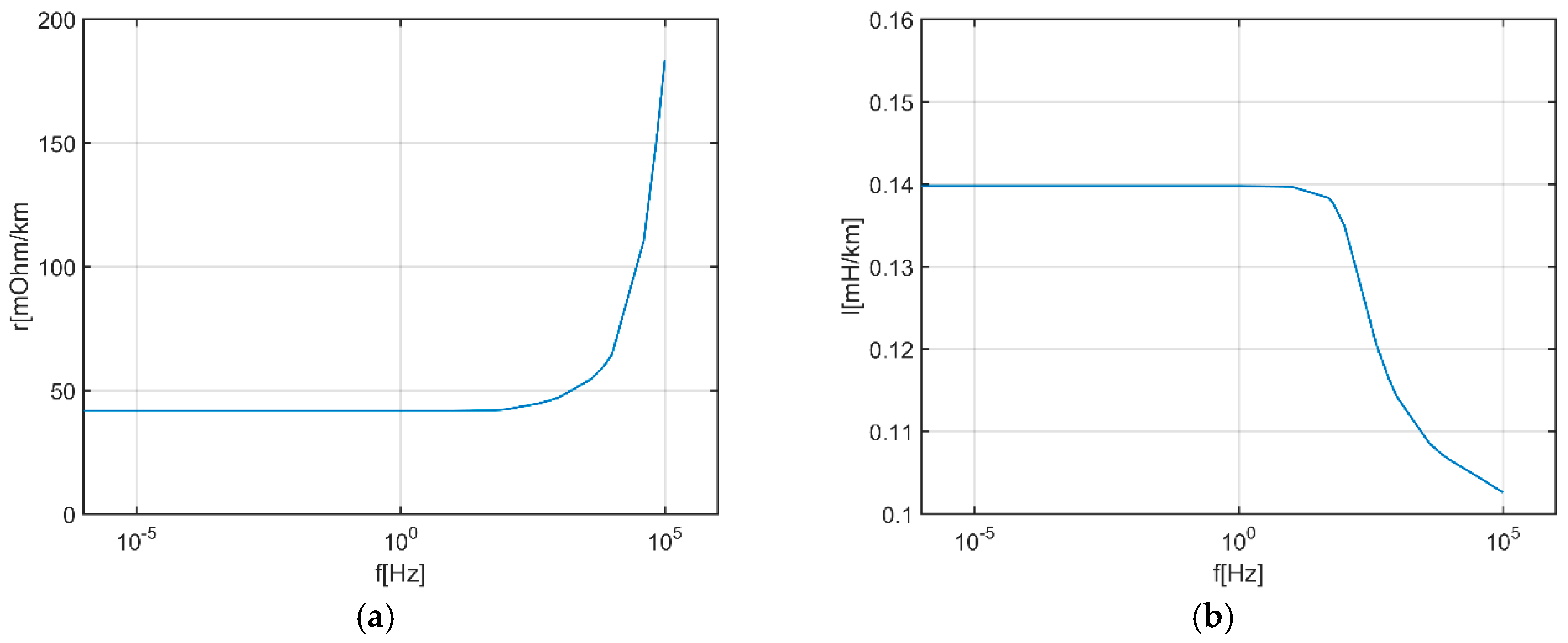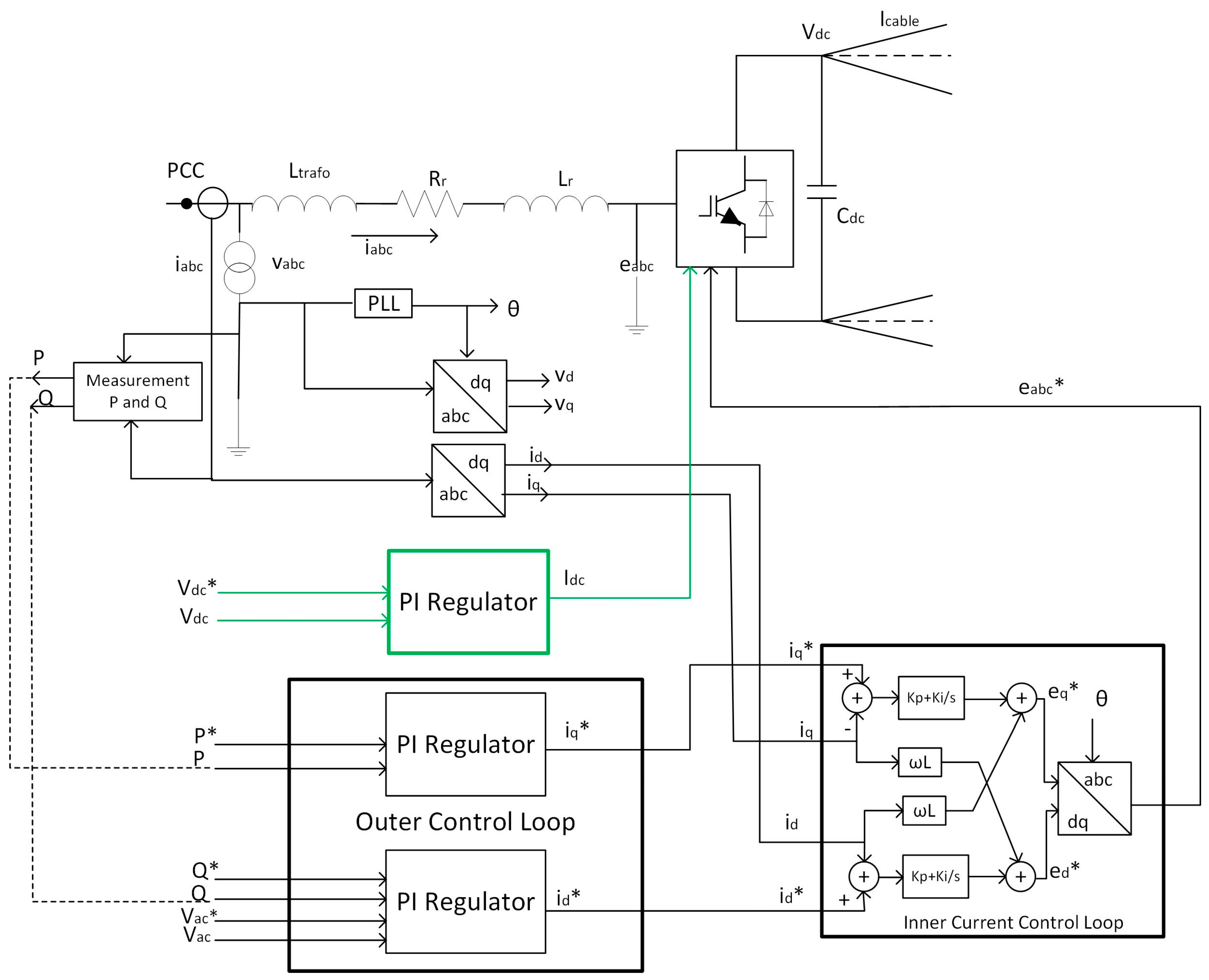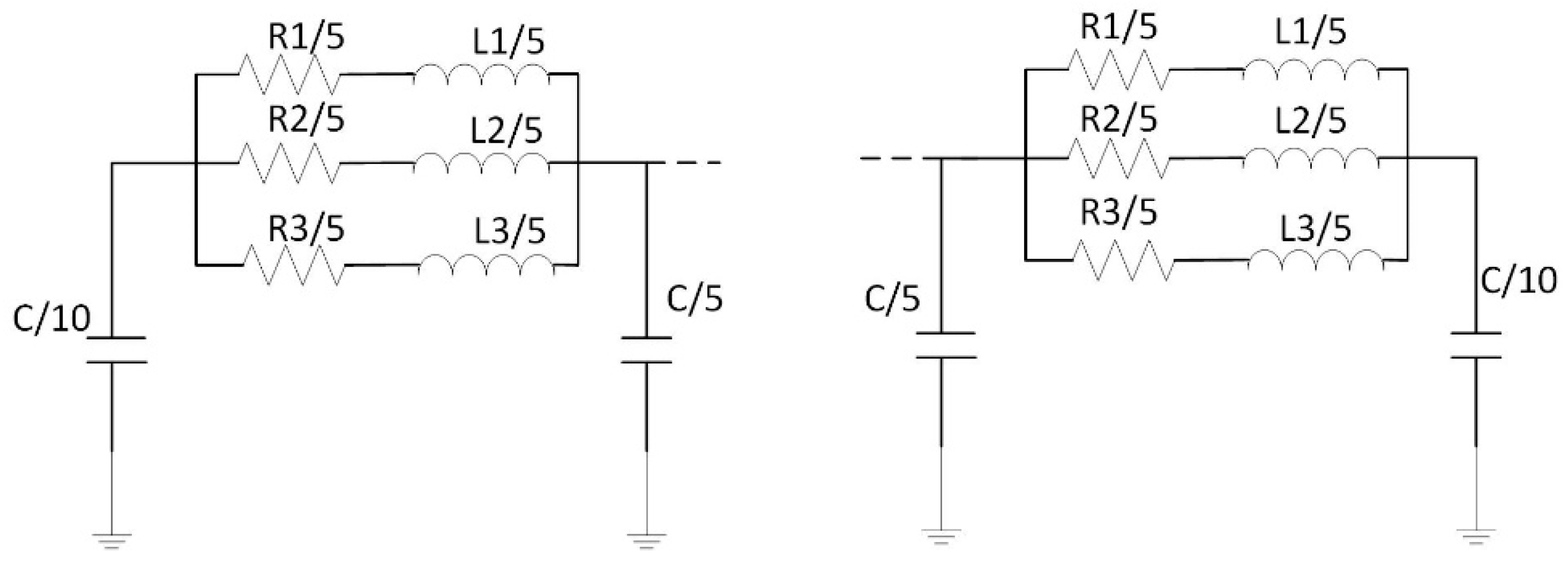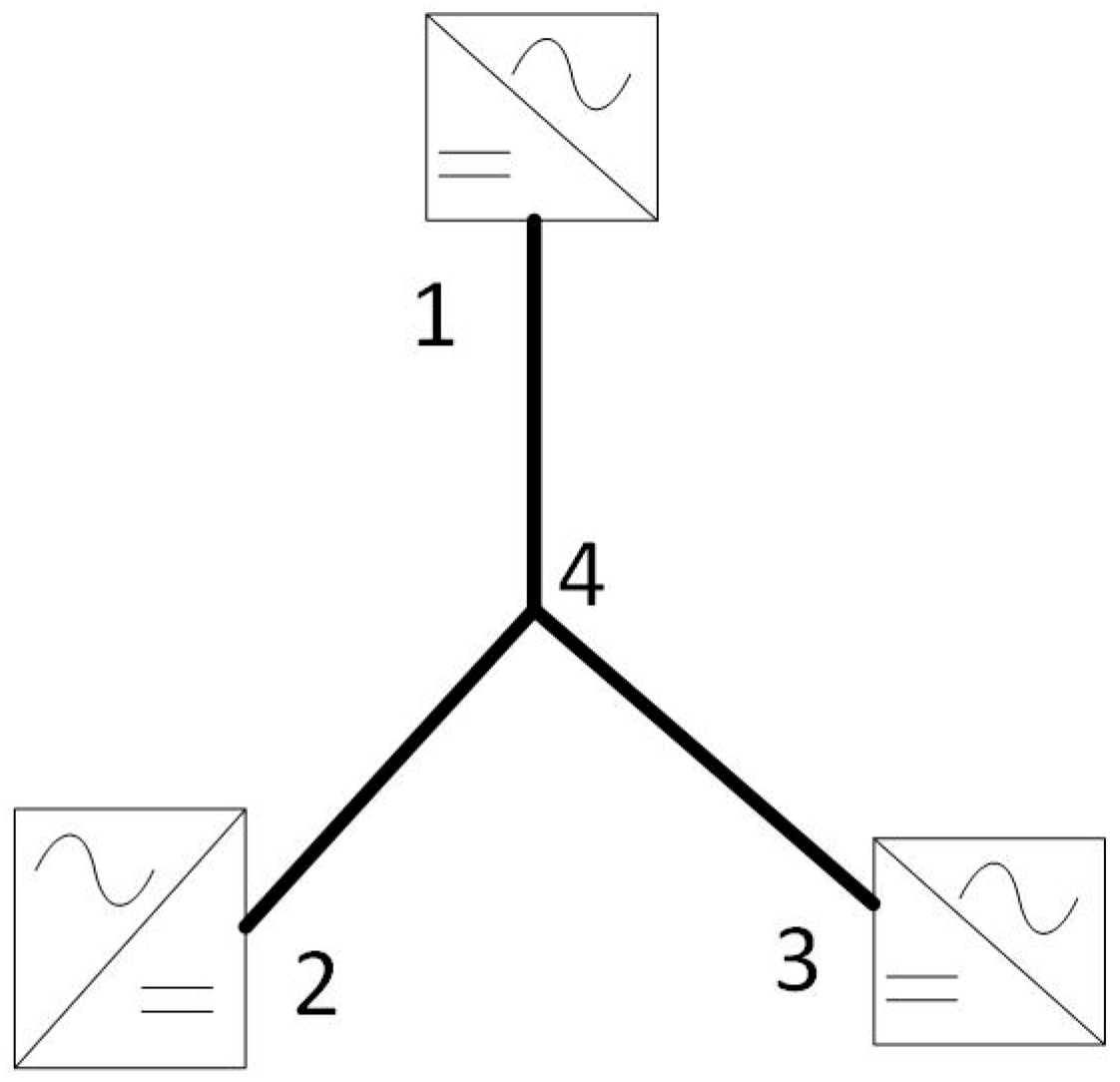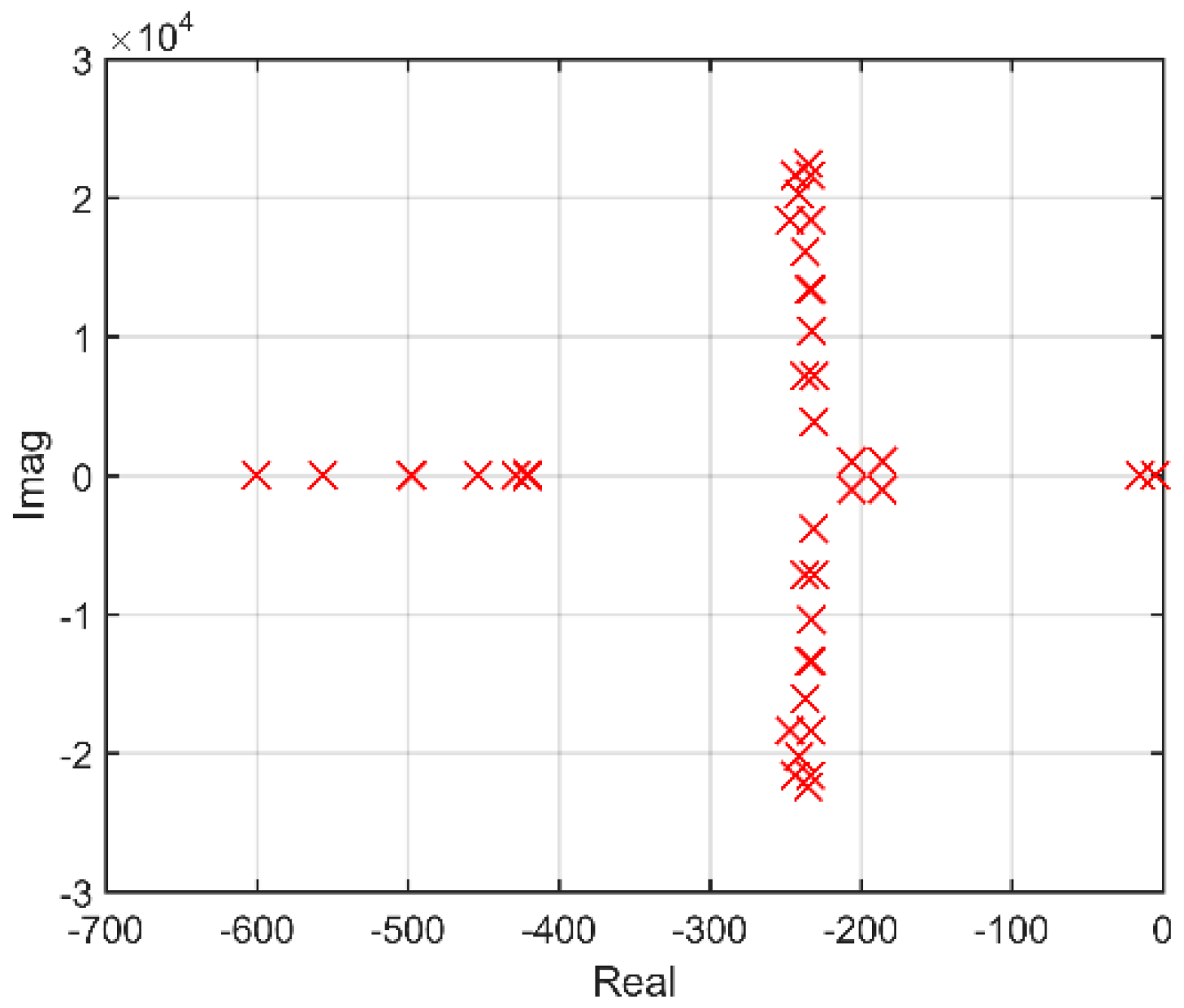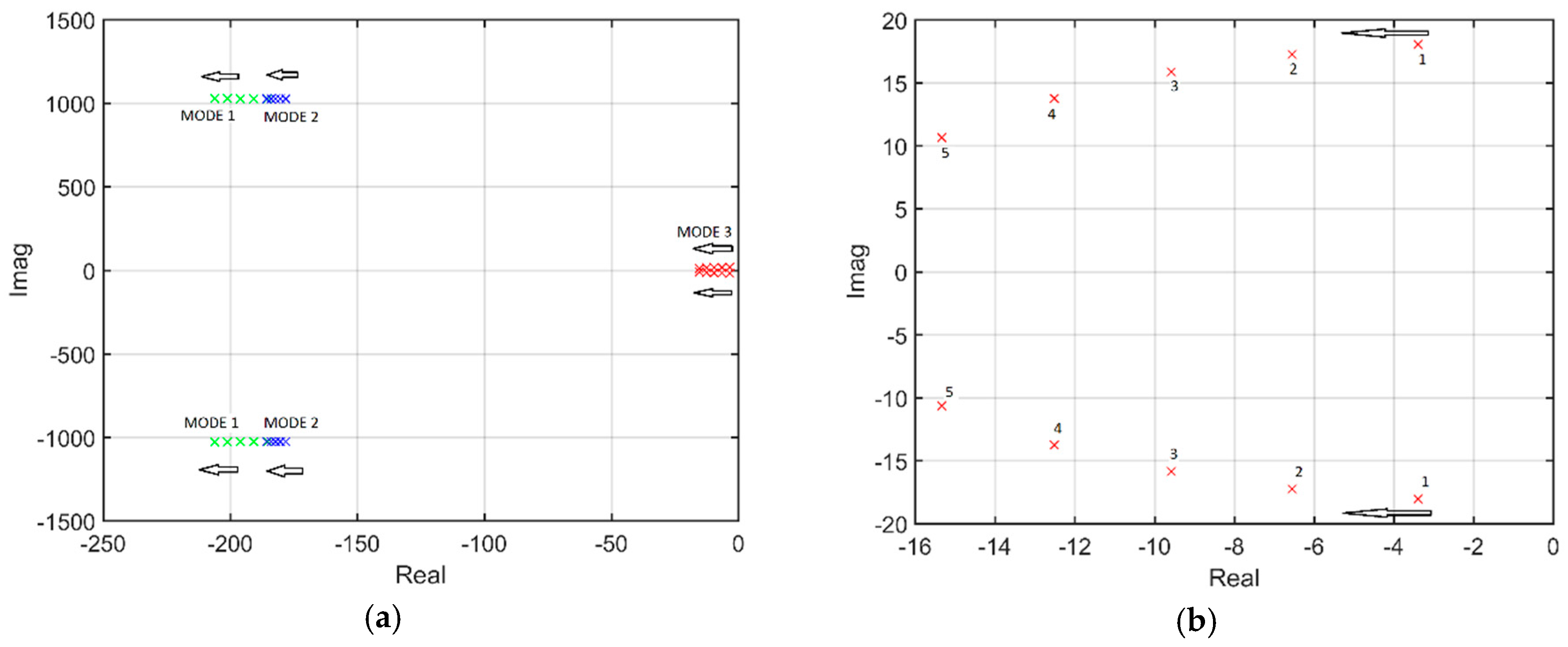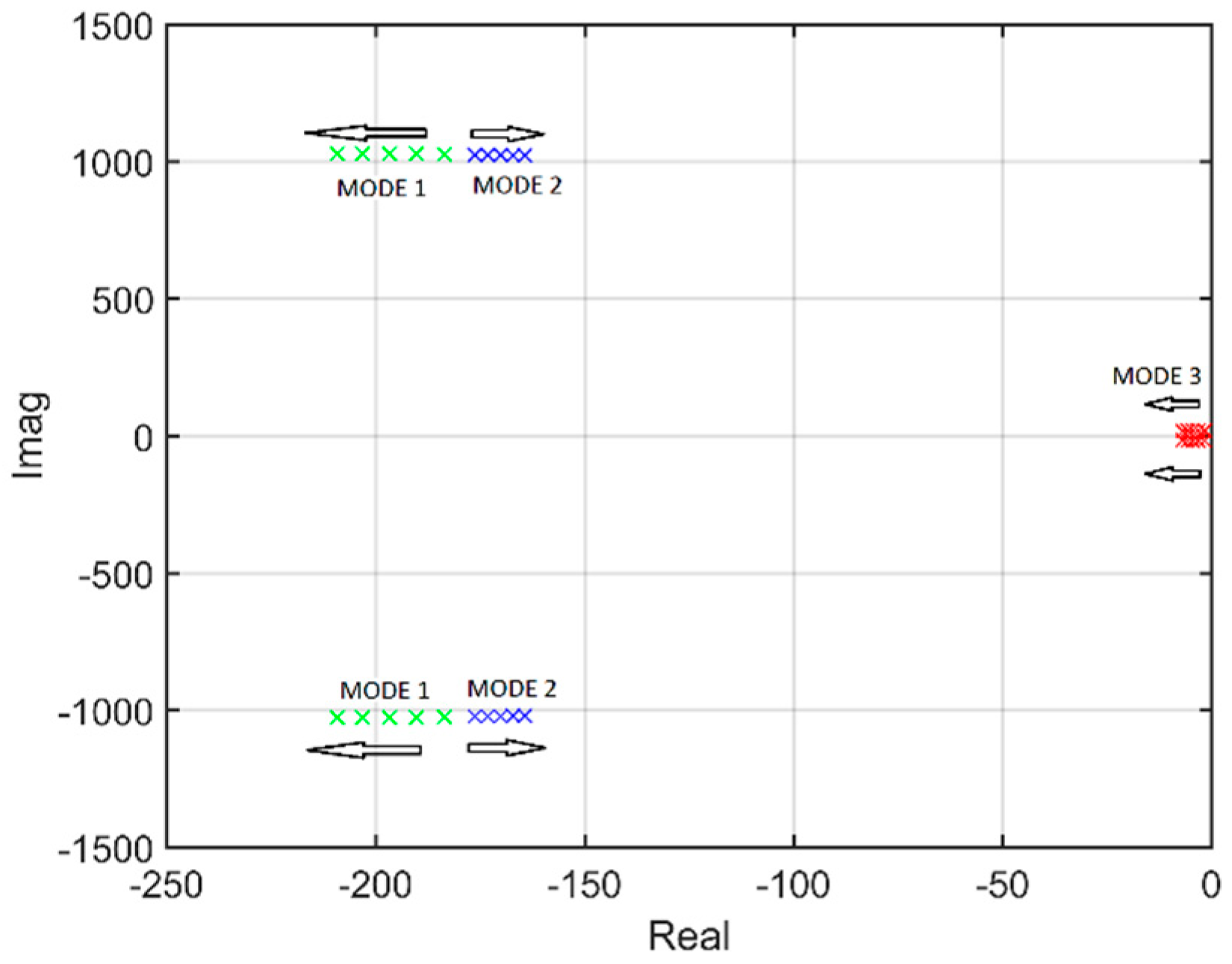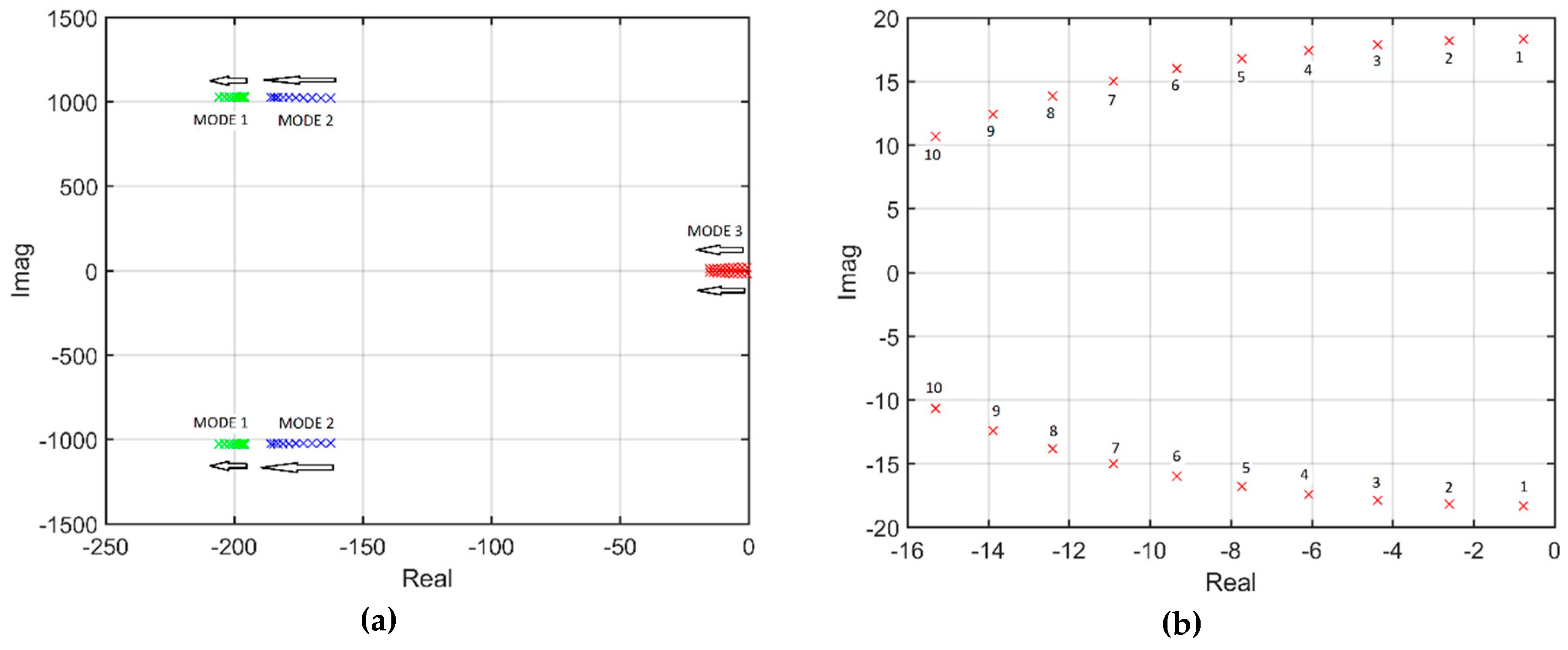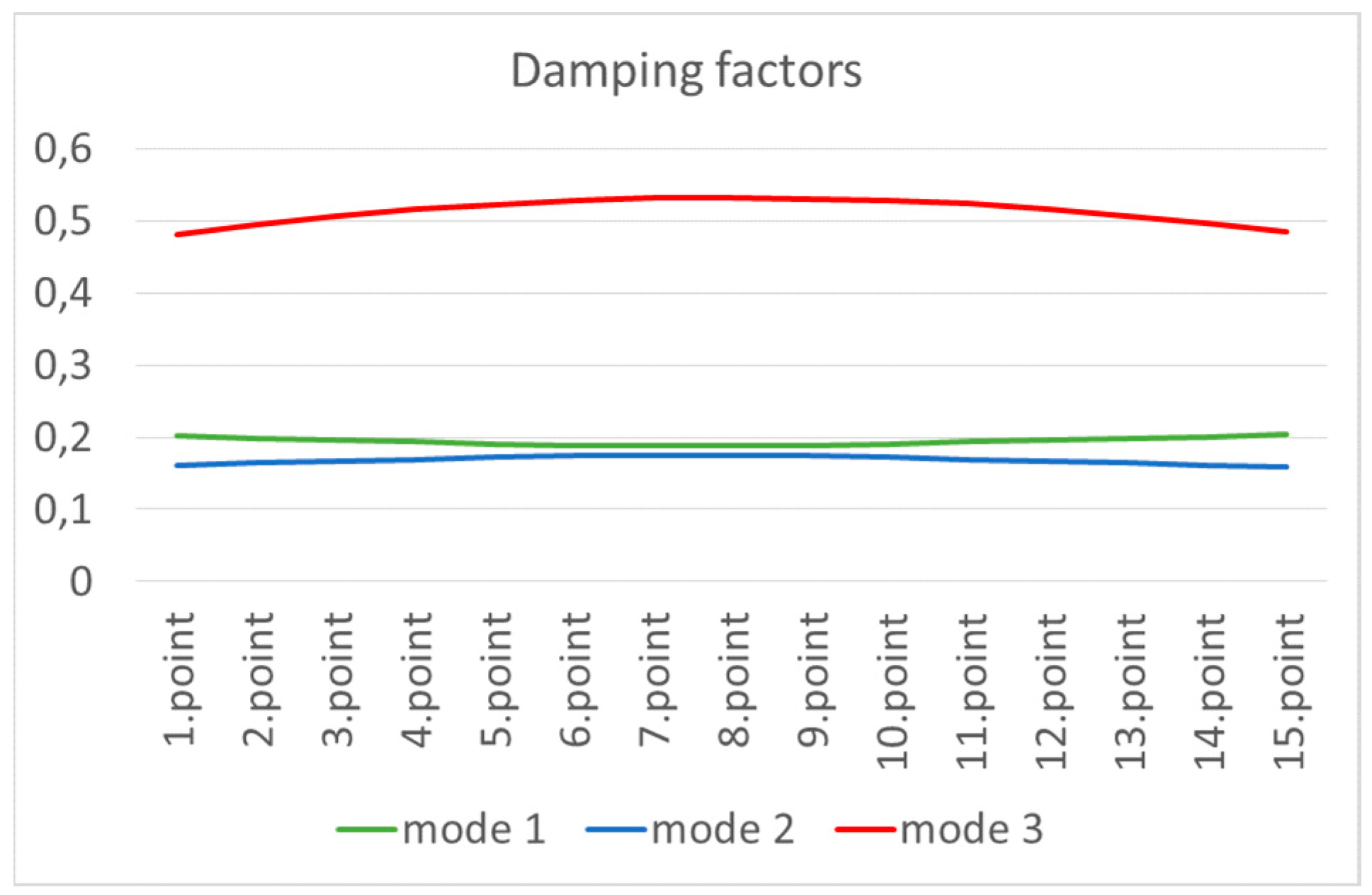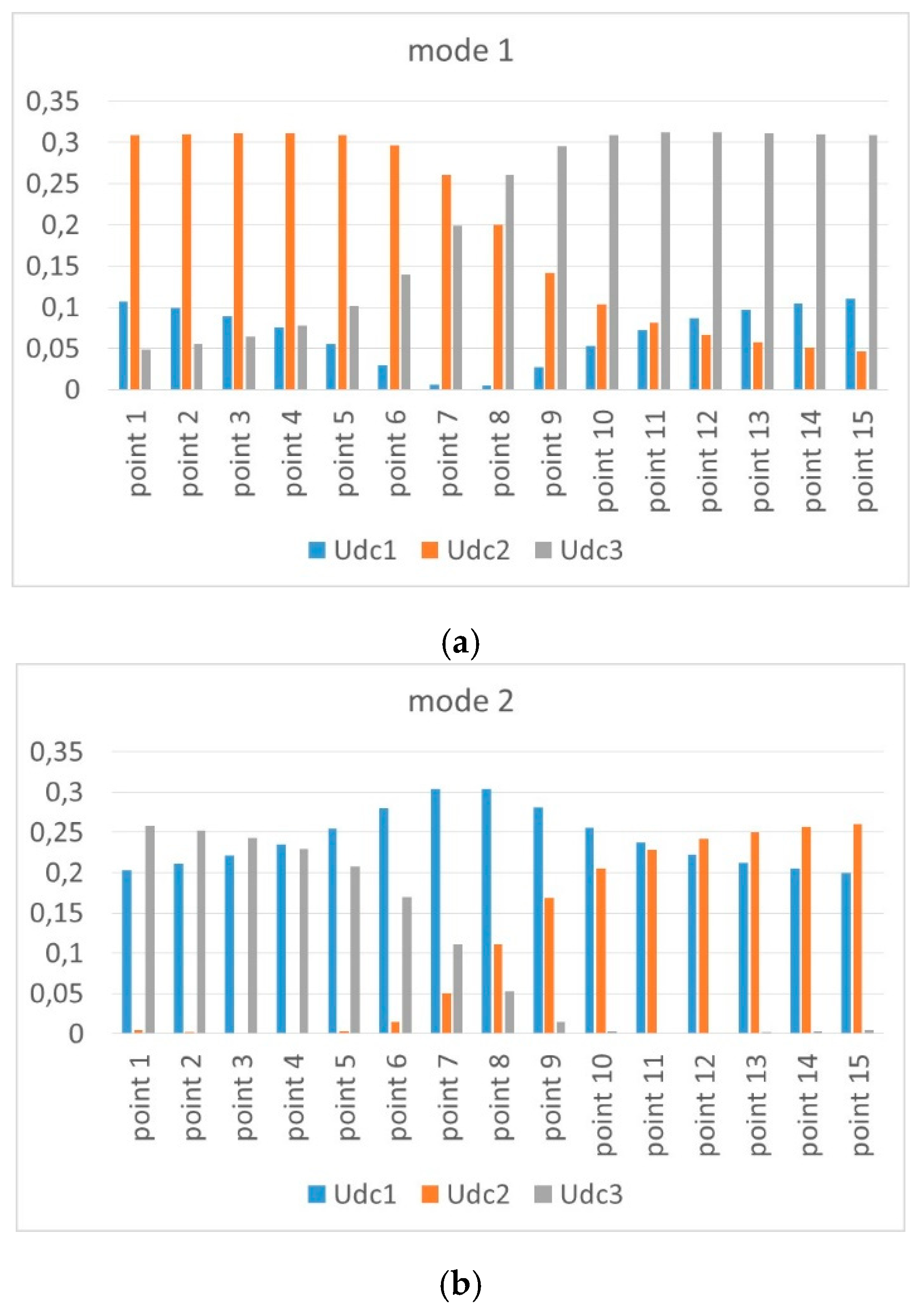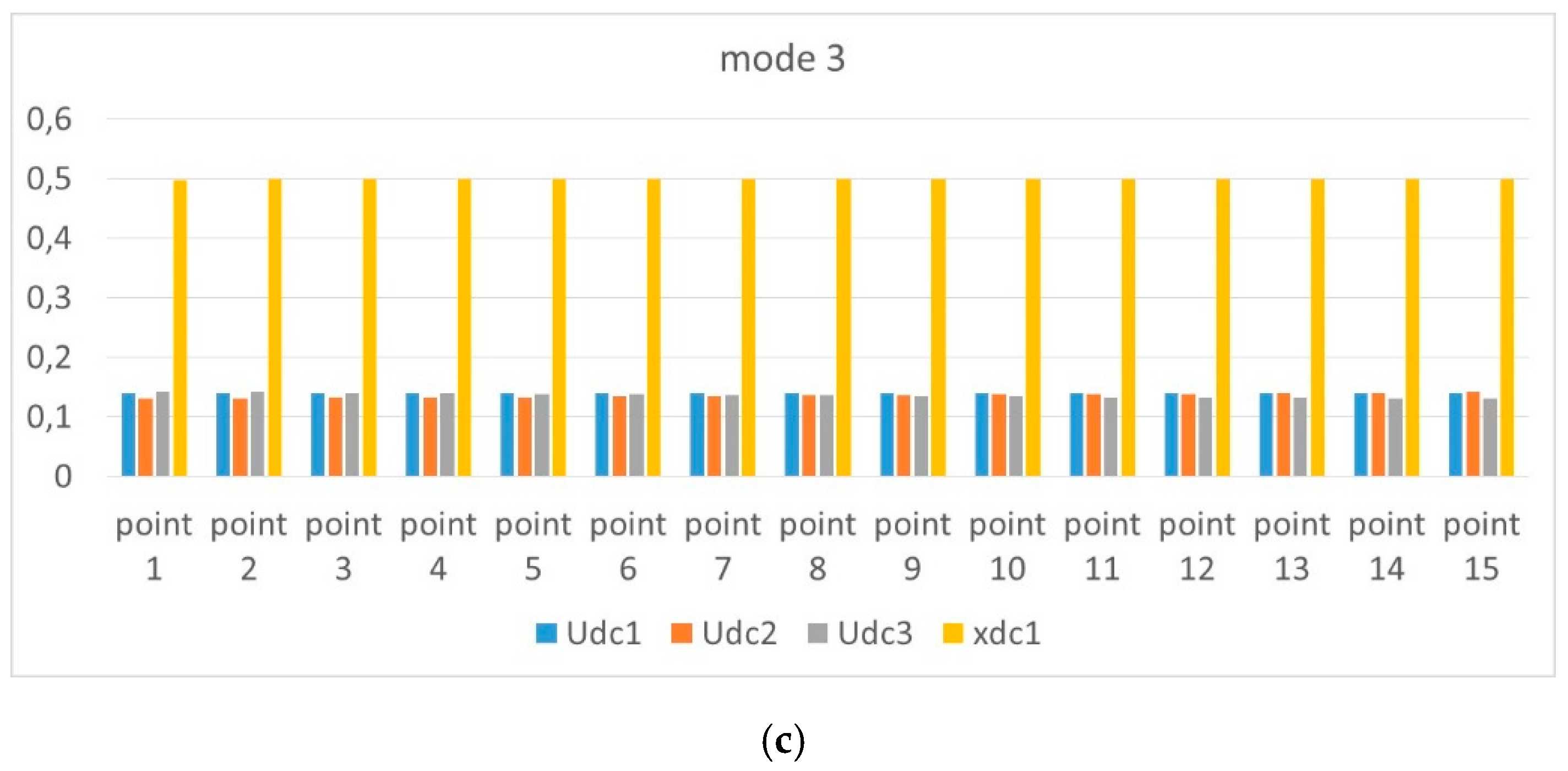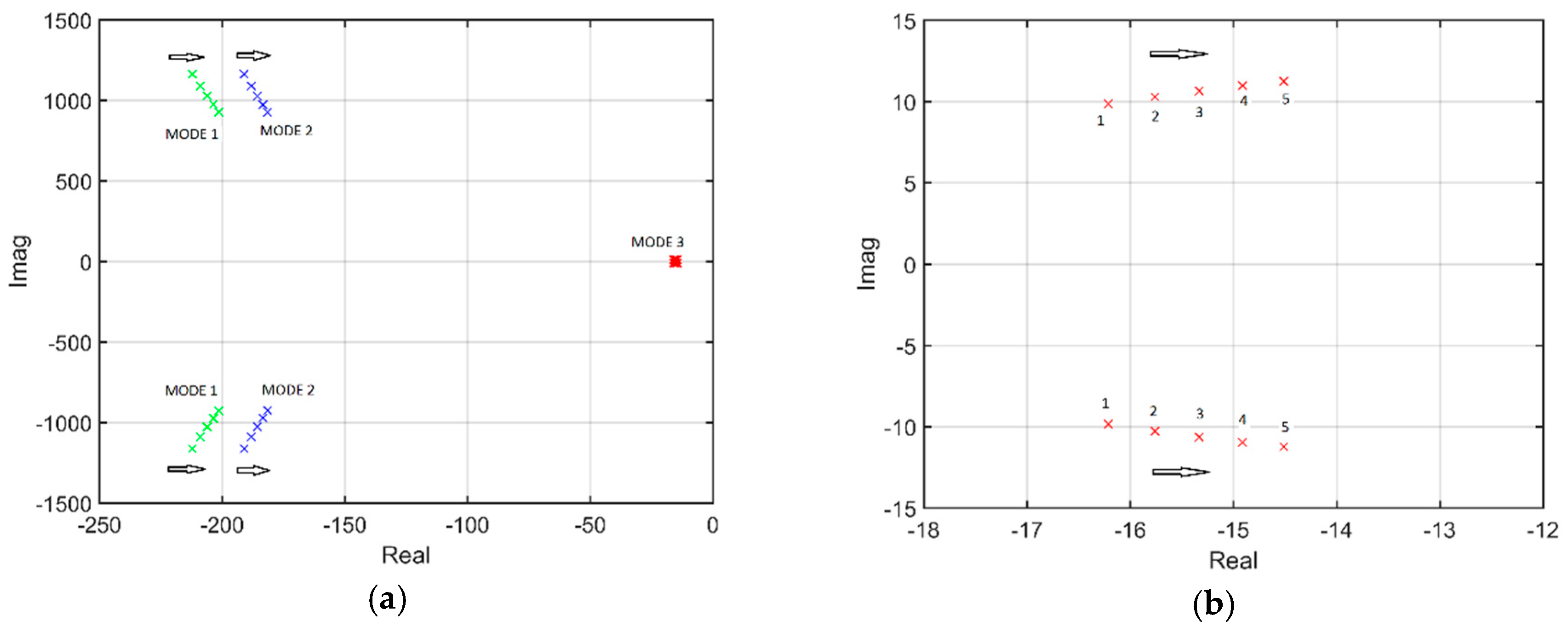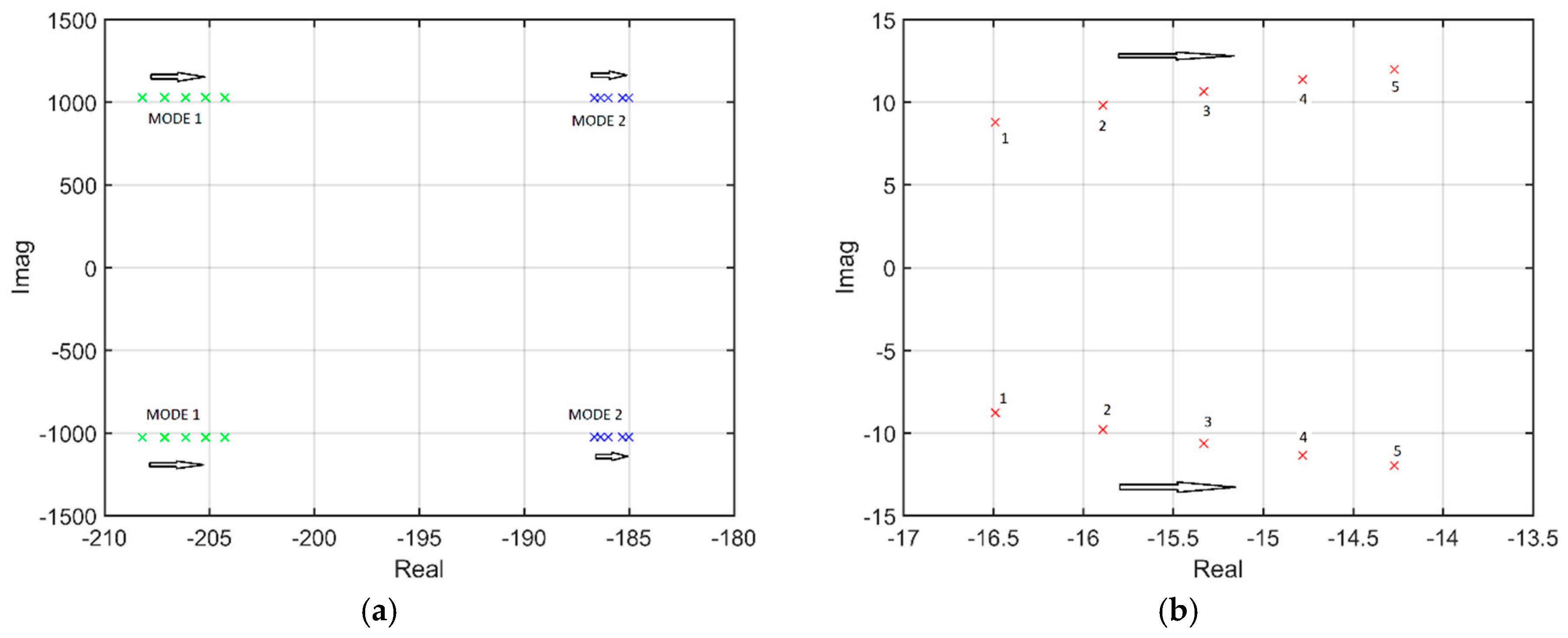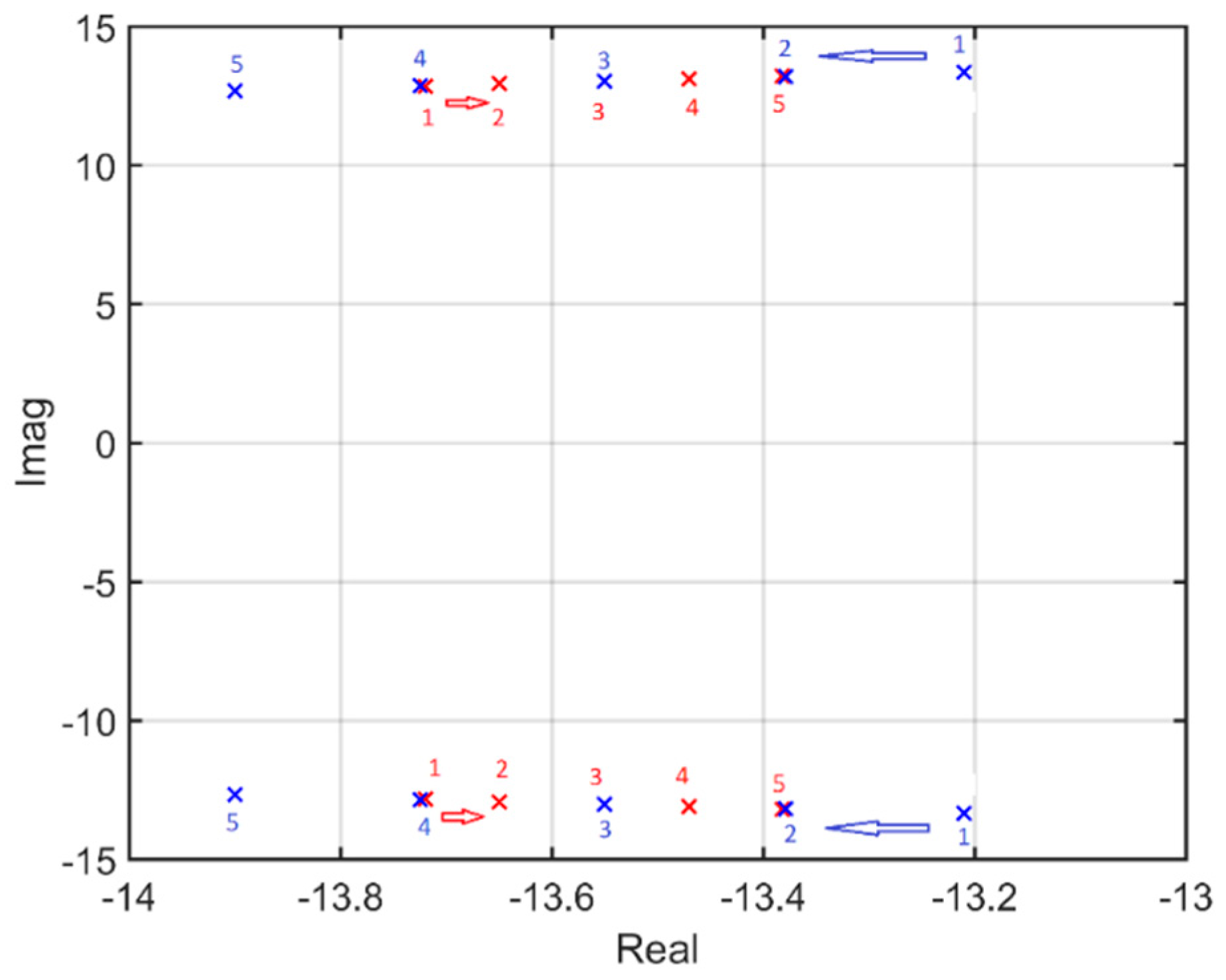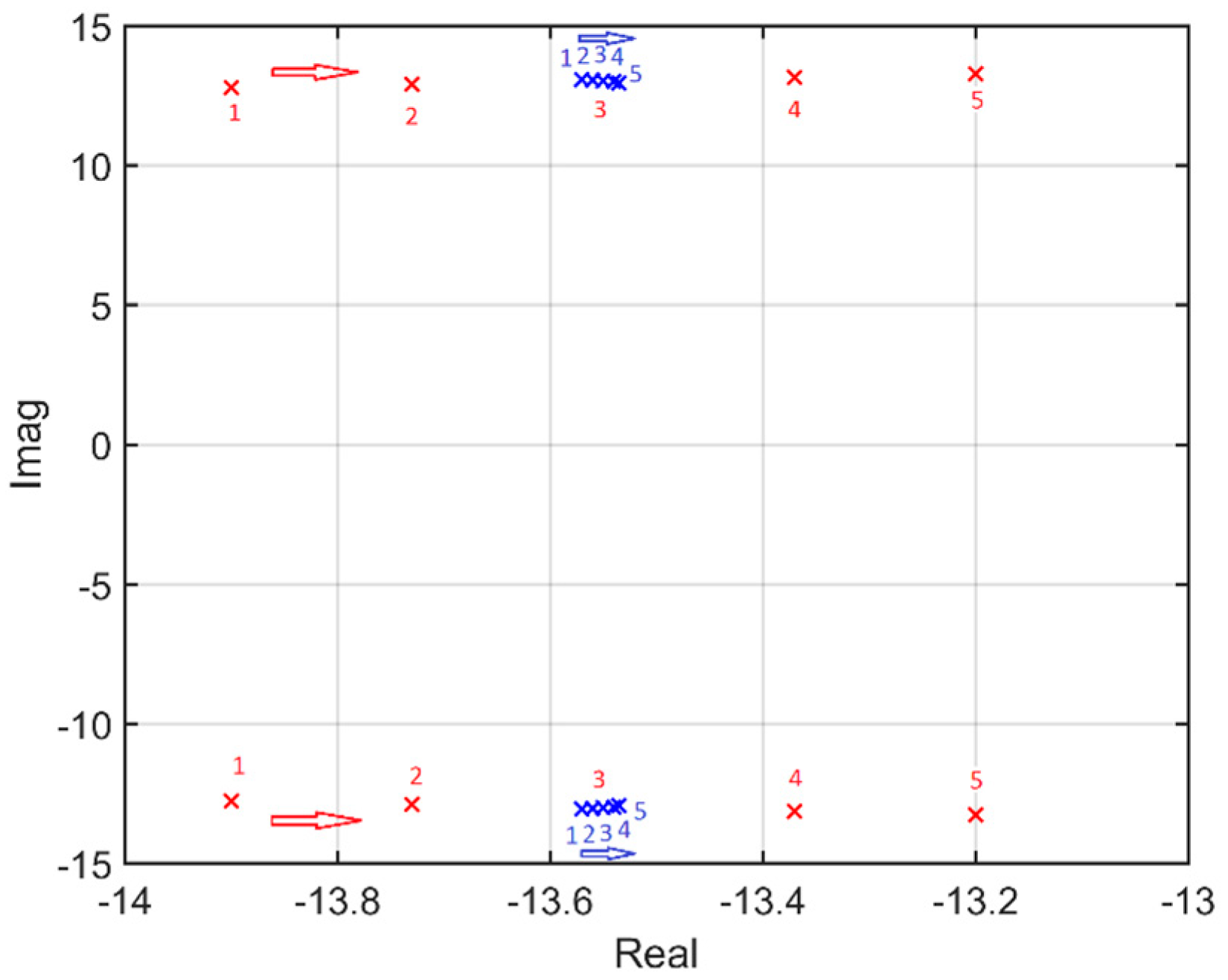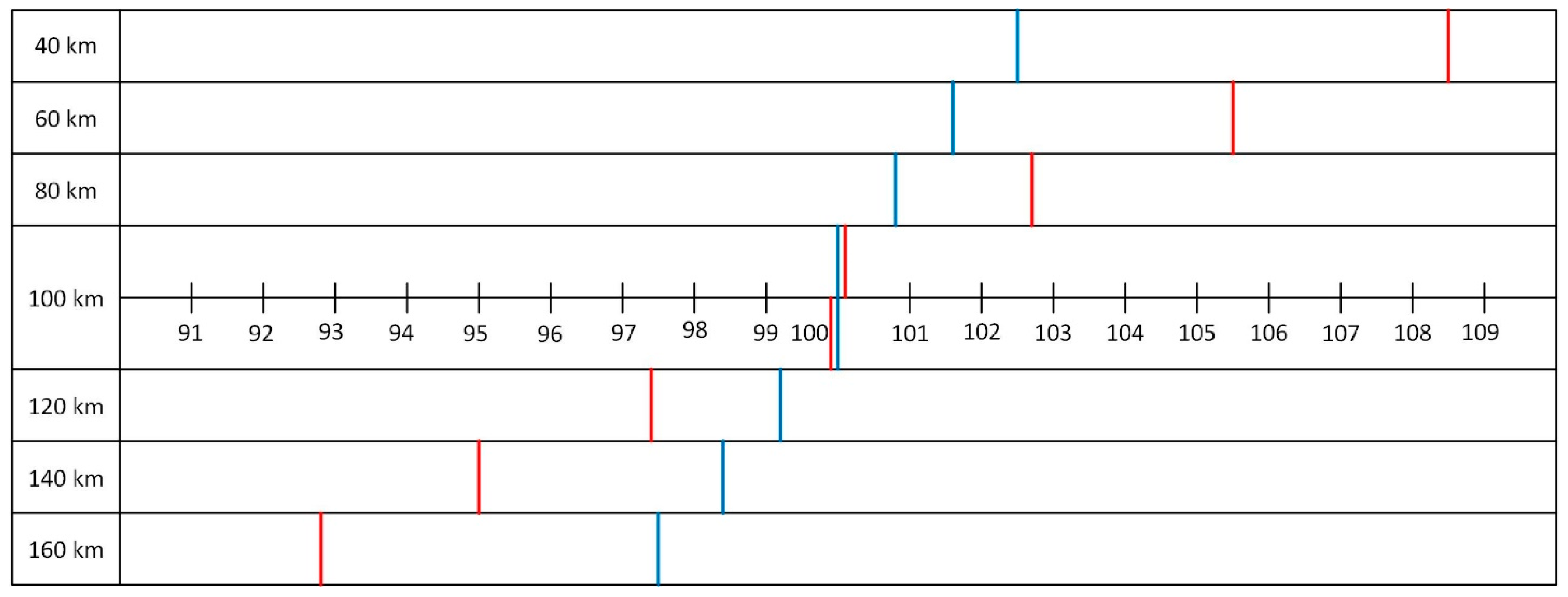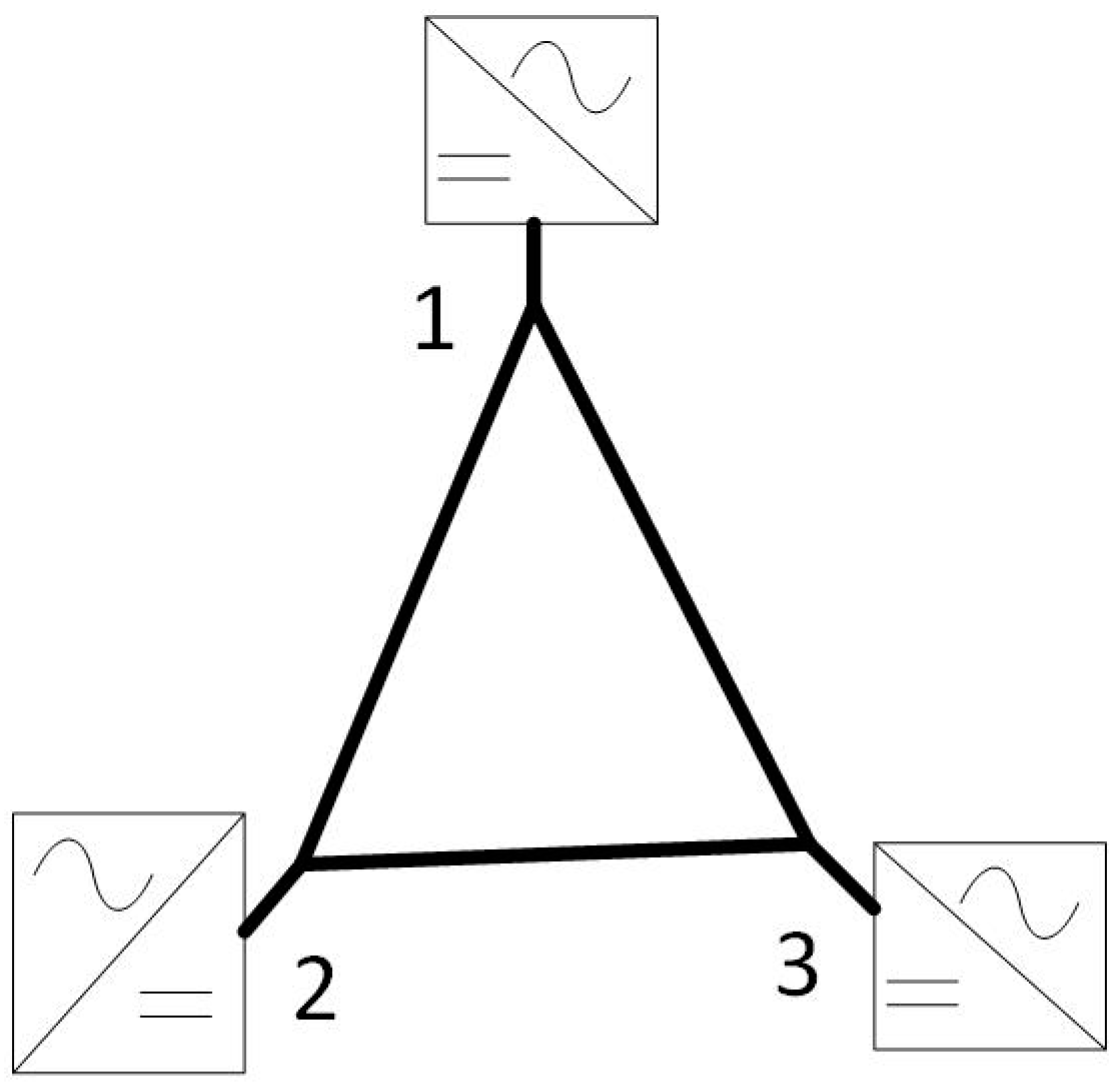Figure 1.
Detailed dynamic time-averaged model of voltage source converter.
Figure 1.
Detailed dynamic time-averaged model of voltage source converter.
Figure 2.
Frequency dependent cable model with five parallel sections and three series branches.
Figure 2.
Frequency dependent cable model with five parallel sections and three series branches.
Figure 3.
Radial DC grid with three nodes.
Figure 3.
Radial DC grid with three nodes.
Figure 4.
Eigenvalues of the grid from
Figure 3.
Figure 4.
Eigenvalues of the grid from
Figure 3.
Figure 5.
Interaction modes of the grid from
Figure 3.
Figure 5.
Interaction modes of the grid from
Figure 3.
Figure 6.
Normalized participation factors of interaction modes: (a) Mode 1; (b) Mode 2; and (c) Mode 3.
Figure 6.
Normalized participation factors of interaction modes: (a) Mode 1; (b) Mode 2; and (c) Mode 3.
Figure 7.
Interaction modes (Case 4.1a): (a) all; and (b) zoom in of Mode 3.
Figure 7.
Interaction modes (Case 4.1a): (a) all; and (b) zoom in of Mode 3.
Figure 8.
Time-domain simulations (Case 4.1a): (a) Direct voltage 1; (b) Direct voltages 2 and 3.
Figure 8.
Time-domain simulations (Case 4.1a): (a) Direct voltage 1; (b) Direct voltages 2 and 3.
Figure 9.
Interaction modes (Case 4.1b).
Figure 9.
Interaction modes (Case 4.1b).
Figure 10.
Interaction modes (Case 4.2): (a) all; and (b) zoom in of Mode 3.
Figure 10.
Interaction modes (Case 4.2): (a) all; and (b) zoom in of Mode 3.
Figure 11.
Damping factors of interaction modes (Case 4.3).
Figure 11.
Damping factors of interaction modes (Case 4.3).
Figure 12.
Normalized participation factors of interaction modes (Case 4.3): (a) Mode 1; (b) Mode 2; and (c) Mode 3.
Figure 12.
Normalized participation factors of interaction modes (Case 4.3): (a) Mode 1; (b) Mode 2; and (c) Mode 3.
Figure 13.
Interaction modes (Case 4.4): (a) all; and (b) zoom in of Mode 3.
Figure 13.
Interaction modes (Case 4.4): (a) all; and (b) zoom in of Mode 3.
Figure 14.
Interaction modes (Case 4.5): (a) Mode 1 and Mode 2; and (b) Mode 3.
Figure 14.
Interaction modes (Case 4.5): (a) Mode 1 and Mode 2; and (b) Mode 3.
Figure 15.
Dominant interaction modes (Case 5.1).
Figure 15.
Dominant interaction modes (Case 5.1).
Figure 16.
Dominant interaction modes (Case 5.2).
Figure 16.
Dominant interaction modes (Case 5.2).
Figure 17.
Dominant interaction modes (Case 5.3).
Figure 17.
Dominant interaction modes (Case 5.3).
Figure 18.
Points of equal currents and stability of dominant interaction modes (Case 5.3).
Figure 18.
Points of equal currents and stability of dominant interaction modes (Case 5.3).
Figure 19.
Triangular DC grid.
Figure 19.
Triangular DC grid.
Figure 20.
Radial DC grid with five nodes.
Figure 20.
Radial DC grid with five nodes.
Table 1.
Converter powers and interaction modes (Case 4.1a).
Table 1.
Converter powers and interaction modes (Case 4.1a).
| | P1 [MW] | P2 [MW] | P3 [MW] | Mode 1 | ξ1 | Mode 2 | ξ2 | Mode 3 | ξ3 |
|---|
| 1 | −19.80 | 10 | 10 | −185.40 ± 1025.2 j | 0.18 | −178.19 ± 1026.3 j | 0.17 | −3.39 ± 18.06 j | 0.18 |
| 2 | −39.23 | 20 | 20 | −190.76 ± 1026.0 j | 0.18 | −180.25 ± 1026.4 j | 0.17 | −6.55 ± 17.25 j | 0.35 |
| 3 | −58.29 | 30 | 30 | −196.04 ± 1026.7 j | 0.19 | −182.14 ± 1026.6 j | 0.17 | −9.58 ± 15.85 j | 0.52 |
| 4 | −77.02 | 40 | 40 | −201.16 ± 1027.3 j | 0.19 | −183.93 ± 1026.7 j | 0.18 | −12.51 ± 13.76 j | 0.67 |
| 5 | −95.42 | 50 | 50 | −206.13 ± 1027.9 j | 0.20 | −185.65 ± 1026.8 j | 0.18 | −15.33 ± 10.64 j | 0.82 |
Table 2.
Converter powers and interaction modes (Case 4.1b).
Table 2.
Converter powers and interaction modes (Case 4.1b).
| | P1 [MW] | P2 [MW] | P3 [MW] | Mode 1 | ξ1 | Mode 2 | ξ2 | Mode 3 | ξ3 |
|---|
| 1 | −9.90 | 20 | −9.90 | −183.48 ± 1026.2 j | 0.18 | −176.23 ± 1024.6 j | 0.17 | −1.71 ± 18.25j | 0.09 |
| 2 | −19.62 | 40 | −19.62 | −190.20 ± 1027.1 j | 0.18 | −173.19 ± 1023.9 j | 0.17 | −3.18 ± 18.09j | 0.17 |
| 3 | −29.15 | 60 | −29.15 | −196.74 ± 1027.6 j | 0.19 | −170.16 ± 1023.3 j | 0.16 | −4.52 ± 17.84j | 0.25 |
| 4 | −38.50 | 80 | −38.50 | −203.10 ± 1027.9 j | 0.19 | −167.18 ± 1022.7 j | 0.16 | −5.74 ± 17.53j | 0.31 |
| 5 | −47.71 | 100 | −47.71 | −209.26 ± 1028.1 j | 0.20 | −164.25 ± 1022.1 j | 0.16 | −6.86 ± 17.16j | 0.37 |
Table 3.
Converter powers and interaction modes (Case 4.2).
Table 3.
Converter powers and interaction modes (Case 4.2).
| | P1 [MW] | P2 [MW] | P3 [MW] | Mode 1 | ξ1 | Mode 2 | ξ2 | Mode 3 | ξ3 |
|---|
| 1 | −7.96 | 60 | −50 | −195.97 ± 1027.6 j | 0.19 | −162.58 ± 1021.7 j | 0.16 | −0.77 ± 18.31 j | 0.04 |
| 2 | −18.20 | 60 | −40 | −196.28 ± 1027.6 j | 0.19 | −166.34 ± 1022.5 j | 0.16 | −2.60 ± 18.18 j | 0.14 |
| 3 | −28.29 | 60 | −30 | −196.70 ± 1027.6 j | 0.19 | −169.87 ± 1023.3 j | 0.16 | −4.37 ± 17.88 j | 0.24 |
| 4 | −38.24 | 60 | −20 | −197.27 ± 1027.6 j | 0.19 | −173.17 ± 1023.9 j | 0.17 | −6.08 ± 17.41 j | 0.33 |
| 5 | −48.07 | 60 | −10 | −198.02 ± 1027.6 j | 0.19 | −176.18 ± 1024.6 j | 0.17 | −7.73 ± 16.78 j | 0.42 |
| 6 | −57.76 | 60 | 0 | −199.01 ± 1027.6 j | 0.19 | −178.87 ± 1025.1 j | 0.17 | −9.34 ± 15.99 j | 0.50 |
| 7 | −67.34 | 60 | 10 | −200.29 ± 1027.7 j | 0.19 | −181.18 ± 1025.6 j | 0.17 | −10.90 ± 15.02 j | 0.59 |
| 8 | −76.79 | 60 | 20 | −201.90 ± 1027.8 j | 0.19 | −183.08 ± 1026.0 j | 0.18 | −12.41 ± 13.84 j | 0.67 |
| 9 | −86.13 | 60 | 30 | −203.81 ± 1027.9 j | 0.19 | −184.60 ± 1026.3 j | 0.18 | −13.88 ± 12.42 j | 0.75 |
| 10 | −95.37 | 60 | 40 | −206.00 ± 1028.1 j | 0.20 | −185.76 ± 1026.6 j | 0.18 | −15.30 ± 10.67 j | 0.82 |
Table 4.
Converter powers and interaction modes (Case 4.3).
Table 4.
Converter powers and interaction modes (Case 4.3).
| | P1 [MW] | P2 [MW] | P3 [MW] | Mode 1 | ξ1 | Mode 2 | ξ2 | Mode 3 | ξ3 |
|---|
| 1 | −60 | 105.1 | −40 | −211.18 ± 1028.2 j | 0.20 | −166.97 ± 1022.7 j | 0.16 | −8.89 ± 16.25 j | 0.48 |
| 2 | −60 | 94.2 | −30 | −208.15 ± 1028.2 j | 0.20 | −170.18 ± 1023.4 j | 0.16 | −9.15± 16.11 j | 0.49 |
| 3 | −60 | 83.5 | −20 | −205.23 ± 1028.1 j | 0.20 | −173.27 ± 1024.0 j | 0.17 | −9.37 ± 15.98 j | 0.51 |
| 4 | −60 | 72.9 | −10 | −202.42 ± 1027.9 j | 0.19 | −176.20 ± 1024.6 j | 0.17 | −9.55 ± 15.88 j | 0.52 |
| 5 | −60 | 62.4 | 0 | −199.82 ± 1027.7 j | 0.19 | −178.87 ± 1025.1 j | 0.17 | −9.68 ± 15.80 j | 0.52 |
| 6 | −60 | 52.1 | 10 | −197.69 ± 1027.4 j | 0.19 | −181.08 ± 1025.7 j | 0.17 | −9.78 ± 15.74 j | 0.53 |
| 7 | −60 | 41.9 | 20 | −196.40 ± 1027.1 j | 0.19 | −182.41 ± 1026.2 j | 0.18 | −9.83 ± 15.70 j | 0.53 |
| 8 | −60 | 31.8 | 30 | −196.43 ± 1026.8 j | 0.19 | −182.38 ± 1026.6 j | 0.18 | −9.85 ± 15.69 j | 0.53 |
| 9 | −60 | 21.85 | 40 | −197.75 ± 1026.7 j | 0.19 | −181.04 ± 102.6 j | 0.17 | −9.83 ± 15.70 j | 0.53 |
| 10 | −60 | 12 | 50 | −199.84 ± 1026.8 j | 0.19 | −178.90 ± 1026.4 j | 0.17 | −9.77 ± 15.74 j | 0.53 |
| 11 | −60 | 2.35 | 60 | −202.32 ± 1026.8 j | 0.19 | −176.37 ± 1026.1 j | 0.17 | −9.69 ± 15.79 j | 0.52 |
| 12 | −60 | −7.3 | 70 | −204.98 ± 1027.0 j | 0.20 | −173.60 ± 1025.7 j | 0.17 | −9.55 ± 15.88 j | 0.52 |
| 13 | −60 | −16.8 | 80 | −207.72 ± 1027.1 j | 0.20 | −170.72 ± 1025.3 j | 0.16 | −9.39 ± 15.98 j | 0.51 |
| 14 | −60 | −26.1 | 90 | −210.52 ± 1027.2 j | 0.20 | −167.80 ± 1024.8 j | 0.16 | −9.20 ± 16.09 j | 0.50 |
| 15 | −60 | −35.4 | 100 | −213.32 ± 1027.3 j | 0.20 | −164.81 ± 1024.2 j | 0.16 | −8.96 ± 16.22 j | 0.48 |
Table 5.
Line lengths, converter powers and interaction modes (Case 4.4).
Table 5.
Line lengths, converter powers and interaction modes (Case 4.4).
| | l1, l2, l3 [km] | P1 [MW] | P2 [MW] | P3 [MW] | Mode 1 | ξ1 | Mode 2 | ξ2 | Mode 3 | ξ3 |
|---|
| 1 | 80 | −96.25 | 50 | 50 | −212.14 ± 1164.1 j | 0.18 | −191.00 ± 1163.2 j | 0.16 | −16.21 ± 9.85 j | 0.85 |
| 2 | 90 | −95.83 | 50 | 50 | −208.95 ± 1090.4 j | 0.19 | −188.15 ± 1089.3 j | 0.17 | −15.76 ± 10.27 j | 0.84 |
| 3 | 100 | −95.42 | 50 | 50 | −206.13 ± 1027.9 j | 0.20 | −185.65 ± 1026.8 j | 0.18 | −15.33 ± 10.64 j | 0.82 |
| 4 | 110 | −95.02 | 50 | 50 | −203.62 ± 974.1 j | 0.20 | −183.46 ± 972.9 j | 0.19 | −14.91 ± 10.97 j | 0.81 |
| 5 | 120 | −94.62 | 50 | 50 | −201.37 ± 927.1 j | 0.21 | −181.51 ± 925.8 j | 0.19 | −14.51 ± 11.25 j | 0.79 |
Table 6.
Referent voltages, converter powers and interaction modes (Case 4.5).
Table 6.
Referent voltages, converter powers and interaction modes (Case 4.5).
| | Vdc1 [pu] | P1 [MW] | P2 [MW] | P3 [MW] | Mode 1 | ξ1 | Mode 2 | ξ2 | Mode 3 | ξ3 |
|---|
| 1 | 0.96 | −95.08 | 50 | 50 | −208.20 ± 1028.1 j | 0.20 | −186.37 ± 1026.8 j | 0.18 | −16.49 ± 8.78 j | 0.88 |
| 2 | 0.98 | −95.25 | 50 | 50 | −207.14 ± 1028.0 j | 0.20 | −186.00 ± 1026.8 j | 0.18 | −15.89 ± 9.80 j | 0.85 |
| 3 | 1.00 | −95.42 | 50 | 50 | −206.13 ± 1027.9 j | 0.20 | −185.65 ± 1026.8 j | 0.18 | −15.33 ± 10.64 j | 0.82 |
| 4 | 1.02 | −95.58 | 50 | 50 | −205.18 ± 1027.8 j | 0.20 | −185.32 ± 1026.8 j | 0.18 | −14.78 ± 11.36 j | 0.79 |
| 5 | 1.04 | –95.73 | 50 | 50 | –204.27 ± 1027.7 j | 0.19 | –185.01 ± 1026.8 j | 0.18 | –14.27 ± 11.98 j | 0.77 |
Table 7.
Converter powers, voltages, currents and dominant interaction modes (Case 5.1).
Table 7.
Converter powers, voltages, currents and dominant interaction modes (Case 5.1).
| | P1 [MW] | P2 [MW] | P3 [MW] | Vdc1 [pu] | Vdc2 [pu] | Vdc3 [pu] | Idc2 [pu] | Idc3 [pu] | Voltage Control 2 | Voltage Control 3 |
|---|
| λ | ξ | λ | ξ |
|---|
| 1 | 222.72 | −100 | −98 | 1 | 0.8914 | 0.8921 | 0.5609 | 0.5493 | −13.72 ± 12.85 j | 0.7298 | −13.21 ± 13.36 j | 0.7031 |
| 2 | 224.01 | −100 | −99 | 1 | 0.8909 | 0.8913 | 0.5612 | 0.5554 | −13.65 ± 12.94 j | 0.7257 | −13.38 ± 13.20 j | 0.7119 |
| 3 | 225.29 | −100 | −100 | 1 | 0.8905 | 0.8905 | 0.5615 | 0.5615 | −13.55 ± 13.03 j | 0.7208 | −13.55 ± 13.03 j | 0.7208 |
| 4 | 226.58 | −100 | −101 | 1 | 0.8901 | 0.8897 | 0.5617 | 0.5676 | −13.47 ± 13.11 j | 0.7166 | −13.72 ± 12.85 j | 0.7299 |
| 5 | 227.87 | −100 | −102 | 1 | 0.8896 | 0.8889 | 0.5621 | 0.5737 | −13.38 ± 13.20 j | 0.7119 | −13.90 ± 12.67 j | 0.7390 |
Table 8.
Line lengths, converter powers, voltages, currents and dominant interaction modes (Case 5.2).
Table 8.
Line lengths, converter powers, voltages, currents and dominant interaction modes (Case 5.2).
| | L3 [km] | P1 [MW] | P2 [MW] | P3 [MW] | Vdc1 [pu] | Vdc2 [pu] | Vdc2 [pu] | Idc2 [pu] | Idc3 [pu] | Voltage Control 2 | Voltage Control 3 |
|---|
| λ | ξ | λ | ξ |
|---|
| 1 | 90 | 224.77 | −100 | −100 | 1 | 0.8907 | 0.8945 | 0.5614 | 0.5590 | −13.90 ± 12.78 j | 0.7361 | −13.57 ± 13.07 j | 0.7203 |
| 2 | 95 | 225.03 | −100 | −100 | 1 | 0.8906 | 0.8925 | 0.5614 | 0.5602 | −13.73 ± 12.91 j | 0.7285 | −13.56 ± 13.05 j | 0.7205 |
| 3 | 100 | 225.29 | −100 | −100 | 1 | 0.8905 | 0.8905 | 0.5615 | 0.5615 | −13.55 ± 13.03 j | 0.7208 | −13.55 ± 13.03 j | 0.7208 |
| 4 | 105 | 225.56 | −100 | −100 | 1 | 0.8904 | 0.8885 | 0.5615 | 0.5627 | −13.37 ± 13.14 j | 0.7132 | −13.54 ± 13.01 j | 0.7211 |
| 5 | 110 | 225.82 | −100 | −100 | 1 | 0.8903 | 0.8865 | 0.5616 | 0.5640 | −13.20 ± 13.26 j | 0.7055 | −13.54 ± 12.94 j | 0.7229 |
Table 9.
Converter powers, voltages, currents and dominant interaction modes (Case 5.3).
Table 9.
Converter powers, voltages, currents and dominant interaction modes (Case 5.3).
| | P1 [MW] | P2 [MW] | P3 [MW] | Vdc1 [pu] | Vdc2 [pu] | Vdc3 [pu] | Idc2 [pu] | Idc3 [pu] | Voltage Control 2 | Voltage Control 3 |
|---|
| λ | ξ | λ | ξ |
|---|
| 1 | 223.26 | −100 | −100 | 1 | 0.8912 | 0.9061 | 0.5610 | 0.5518 | −14.93 ± 11.99 j | 0.7797 | −13.62 ± 13.19 j | 0.7184 |
| 2 | 224.50 | −100 | −101 | 1 | 0.8908 | 0.9055 | 0.5613 | 0.5577 | −14.87 ± 12.07 j | 0.7764 | −13.80 ± 13.02 j | 0.7274 |
| 3 | 225.74 | −100 | −102 | 1 | 0.8904 | 0.9049 | 0.5615 | 0.5636 | −14.80 ± 12.16 j | 0.7727 | −13.97 ± 12.84 j | 0.7363 |
| 4 | 226.99 | −100 | −103 | 1 | 0.8899 | 0.9042 | 0.5619 | 0.5696 | −14.74 ± 12.24 j | 0.7693 | −14.14 ± 12.66 j | 0.7450 |
| 5 | 228.24 | −100 | −104 | 1 | 0.8895 | 0.9036 | 0.5621 | 0.5755 | −14.67 ± 12.32 j | 0.7658 | −14.31 ± 12.47 j | 0.7539 |
| 6 | 229.49 | −100 | −105 | 1 | 0.8892 | 0.9030 | 0.5623 | 0.5814 | −14.60 ± 12.41 j | 0.7619 | −14.48 ± 12.28 j | 0.7627 |
| 7 | 230.74 | −100 | −106 | 1 | 0.8887 | 0.9023 | 0.5626 | 0.5874 | −14.54 ± 12.49 j | 0.7586 | −14.65 ± 12.08 j | 0.7715 |
Table 10.
Converter powers, voltages, currents and dominant interaction modes (Case 5.4.1).
Table 10.
Converter powers, voltages, currents and dominant interaction modes (Case 5.4.1).
| | P1 [MW] | P2 [MW] | P3 [MW] | Vdc1 [pu] | Vdc2 [pu] | Vdc3 [pu] | Idc2 [pu] | Idc3 [pu] | Voltage Control 2 | Voltage Control 3 |
|---|
| λ | ξ | λ | ξ |
|---|
| 1 | 222.72 | −100 | −98 | 1 | 0.8914 | 0.8921 | 0.5609 | 0.5493 | −10.26 ± 12.58 j | 0.6320 | −9.88 ± 12.87 j | 0.6089 |
| 2 | 224.01 | −100 | −99 | 1 | 0.8909 | 0.8913 | 0.5612 | 0.5554 | −10.20 ± 12.63 j | 0.6283 | −10.00 ± 12.77 j | 0.6165 |
| 3 | 225.29 | −100 | −100 | 1 | 0.8905 | 0.8905 | 0.5615 | 0.5615 | −10.13 ± 12.68 j | 0.6242 | −10.13 ± 12.68 j | 0.6242 |
| 4 | 226.58 | −100 | −101 | 1 | 0.8901 | 0.8897 | 0.5617 | 0.5676 | −10.07 ± 12.73 j | 0.6204 | −10.26 ± 12.58 j | 0.6320 |
| 5 | 227.87 | – | – | 1 | 0.8896 | 0.8889 | 0.5621 | 0.5737 | −10.00 ± 12.78 j | 0.6162 | −10.39 ± 12.48 j | 0.6398 |
Table 11.
Line length, power of converters, voltages, currents and dominant interaction modes (Case 5.4.2).
Table 11.
Line length, power of converters, voltages, currents and dominant interaction modes (Case 5.4.2).
| | L12 [km] | L13 [km] | L23 [km] | P1 [MW] | P2 [MW] | P3 [MW] | Vdc1 [pu] | Vdc2 [pu] | Vdc2 [pu] | Idc2 [pu] | Idc3 [pu] | Voltage Control 2 | Voltage Control 3 |
|---|
| λ | ξ | λ | ξ |
|---|
| 1 | 311.11 | 280 | 280 | 224.77 | −100 | −100 | 1 | 0.8907 | 0.8945 | 0.5614 | 0.5590 | −10.47 ± 12.58 j | 0.6397 | −10.21 ± 12.73 j | 0.6257 |
| 2 | 205.26 | 290 | 290 | 225.03 | −100 | −100 | 1 | 0.8906 | 0.8925 | 0.5614 | 0.5602 | −10.30 ± 12.63 j | 0.6320 | −10.17 ± 12.70 j | 0.6251 |
| 3 | 300 | 300 | 300 | 225.29 | −100 | −100 | 1 | 0.8905 | 0.8905 | 0.5615 | 0.5615 | −10.13 ± 12.68 j | 0.6242 | −10.13 ± 12.68 j | 0.6242 |
| 4 | 295.24 | 310 | 310 | 225.56 | −100 | −100 | 1 | 0.8904 | 0.8885 | 0.5615 | 0.5627 | −9.96 ± 12.72 j | 0.6165 | −10.09 ± 12.65 j | 0.6236 |
| 5 | 290.91 | 320 | 320 | 225.82 | −100 | −100 | 1 | 0.8903 | 0.8865 | 0.5616 | 0.5640 | −9.79 ± 12.76 j | 0.6087 | −10.05 ± 12.62 j | 0.6230 |
Table 12.
Converter powers, voltages, currents and dominant interaction modes (Case 5.3).
Table 12.
Converter powers, voltages, currents and dominant interaction modes (Case 5.3).
| | P1 [MW] | P2 [MW] | P3 [MW] | Vdc1 [pu] | Vdc2 [pu] | Vdc3 [pu] | Idc2 [pu] | Idc3 [pu] | Voltage Control 2 | Voltage Control 3 |
|---|
| λ | ξ | λ | ξ |
|---|
| 1 | 223.26 | −100 | −100 | 1 | 0.8912 | 0.9061 | 0.5610 | 0.5518 | −11.38 ± 12.22 j | 0.6815 | −10.36 ± 12.86 j | 0.6273 |
| 2 | 224.50 | −100 | −101 | 1 | 0.8908 | 0.9055 | 0.5613 | 0.5577 | −11.33 ± 12.27 j | 0.6784 | −10.49 ± 12.76 j | 0.6350 |
| 3 | 225.74 | −100 | −102 | 1 | 0.804 | 0.9049 | 0.5615 | 0.5636 | −11.28 ± 12.32 j | 0.6753 | −10.62 ± 12.66 j | 0.6427 |
| 4 | 226.99 | −100 | −103 | 1 | 0.8899 | 0.9042 | 0.5619 | 0.5696 | −11.23 ± 12.37 j | 0.6722 | −10.75 ± 12.55 j | 0.6505 |
| 5 | 228.24 | −100 | −104 | 1 | 0.8895 | 0.9036 | 0.5621 | 0.5755 | −11.18 ± 12.41 j | 0.6693 | −10.88 ± 12.44 j | 0.6583 |
| 6 | 229.49 | −100 | −105 | 1 | 0.8892 | 0.9030 | 0.5623 | 0.5814 | −11.13 ± 12.46 j | 0.6662 | −11.01 ± 12.33 j | 0.6661 |
| 7 | 230.74 | −100 | −106 | 1 | 0.8887 | 0.9023 | 0.5626 | 0.5874 | −11.07 ± 12.51 j | 0.6627 | −11.14 ± 12.22 j | 0.6737 |
Table 13.
Line lengths, converter powers, voltages, currents and dominant interaction modes (Case 5.5.1).
Table 13.
Line lengths, converter powers, voltages, currents and dominant interaction modes (Case 5.5.1).
| Converter | L [km] | P [MW] | Vdc [pu] | Idc [pu] | λ |
|---|
| Converter 1 | 20 | 203.86 | 1 | 1.0193 | — |
| Converter 2 | 20 | −50 | 0.9794 | 0.2553 | −4.88 ± 14.71 j |
| Converter 3 | 20 | −60 | 0.9787 | 0.3065 | −6.15 ± 14.23 j |
| Converter 4 | 20 | −70 | 0.9781 | 0.3578 | −7.43 ± 13.61 j |
| Converter 5 | 20 | −80 | 0.9774 | 0.4092 | −8.71 ± 12.86 j |
Table 14.
Line lengths, converter powers, voltages, currents and dominant interaction modes (Case 5.5.2).
Table 14.
Line lengths, converter powers, voltages, currents and dominant interaction modes (Case 5.5.2).
| Converter | L [km] | P [MW] | Vdc [pu] | Idc [pu] | λ |
|---|
| Converter 1 | 20 | 204.93 | 1 | 1.0247 | — |
| Converter 2 | 20 | −50 | 0.9834 | 0.2542 | −4.82 ± 14.21 j |
| Converter 3 | 40 | −50 | 0.9801 | 0.2551 | −4.91 ± 14.21 j |
| Converter 4 | 60 | −50 | 0.9767 | 0.2560 | −5.00 ± 14.21 j |
| Converter 5 | 80 | −50 | 0.9734 | 0.2568 | −5.09 ± 14.21 j |
Table 15.
Line lengths, converter powers, voltages, currents and dominant interaction modes (Case 5.5.3).
Table 15.
Line lengths, converter powers, voltages, currents and dominant interaction modes (Case 5.5.3).
| Converter | L [km] | P [MW] | Vdc [pu] | Idc [pu] | λ |
|---|
| Converter 1 | 20 | 205.45 | 1 | 1.0273 | — |
| Converter 2 | 20 | −50.5 | 0.9833 | 0.2568 | −4.88 ± 14.19 j |
| Converter 3 | 40 | −50 | 0.9801 | 0.2551 | −4.91 ± 14.21 j |
| Converter 4 | 60 | −50 | 0.9767 | 0.2560 | −5.00 ± 14.21 j |
| Converter 5 | 80 | −50 | 0.9733 | 0.2569 | −5.09 ± 14.21 j |
Table 16.
Droop coefficients and dominant interaction modes (Case 5.5.4).
Table 16.
Droop coefficients and dominant interaction modes (Case 5.5.4).
| | g2 | g3 | g4 | g5 | λ | ξ |
|---|
| 1. | 0.1 | 0.5 | 1 | 2.5 | −1.2486 ± 22.4053 j | 0.0556 |
| 2. | 0.1 | 0.5 | 2.5 | 1 | −1.2476 ± 22.4114 j | 0.0556 |
| 3. | 0.1 | 1 | 0.5 | 2.5 | −1.2395 ± 22.3679 j | 0.0553 |
| 4. | 0.1 | 1 | 2.5 | 0.5 | −1.2382 ± 22.3761 j | 0.0553 |
| 5. | 0.1 | 2.5 | 0.5 | 1 | −1.2102 ± 22.2620 j | 0.0543 |
| 6. | 0.1 | 2.5 | 1 | 0.5 | −1.2098 ± 22.2641 j | 0.0543 |
| 7. | 0.5 | 0.1 | 1 | 2.5 | −1.2413 ± 22.3735 j | 0.0554 |
| 8. | 0.5 | 0.1 | 2.5 | 1 | −1.2404 ± 22.3796 j | 0.0553 |
| 9. | 0.5 | 1 | 0.1 | 2.5 | −1.2248 ± 22.3061 j | 0.0548 |
| 10. | 0.5 | 1 | 2.5 | 0.1 | −1.2233 ± 22.3158 j | 0.0547 |
| 11. | 0.5 | 2.5 | 0.1 | 1 | −1.1953 ± 22.1999 j | 0.0538 |
| 12. | 0.5 | 2.5 | 1 | 0.1 | −1.1947 ± 22.2036 j | 0.0537 |
| 13. | 1 | 0.1 | 0.5 | 2.5 | −1.2228 ± 22.2962 j | 0.0548 |
| 14. | 1 | 0.1 | 2.5 | 0.5 | −1.2215 ± 22.3044 j | 0.0547 |
| 15. | 1 | 0.5 | 0.1 | 2.5 | −1.2154 ± 22.2662 j | 0.0545 |
| 16. | 1 | 0.5 | 2.5 | 0.1 | −1.2139 ± 22.2760 j | 0.0544 |
| 17. | 1 | 2.5 | 0.1 | 0.5 | −1.1760 ± 22.1243 j | 0.0531 |
| 18. | 1 | 2.5 | 0.5 | 0.1 | −1.1757 ± 22.1259 j | 0.0531 |
| 19. | 2.5 | 0.1 | 0.5 | 1 | −1.1631 ± 22.0703 j | 0.0526 |
| 20. | 2.5 | 0.1 | 1 | 0.5 | −1.1628 ± 22.0724 j | 0.0526 |
| 21. | 2.5 | 0.5 | 0.1 | 1 | −1.1555 ± 22.0401 j | 0.0524 |
| 22. | 2.5 | 0.5 | 1 | 0.1 | −1.1550 ± 22.0437 j | 0.0523 |
| 23. | 2.5 | 1 | 0.1 | 0.5 | −1.1456 ± 22.0043 j | 0.0520 |
| 24. | 2.5 | 1 | 0.5 | 0.1 | −1.1454 ± 22.0059 j | 0.0520 |
